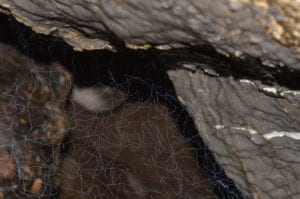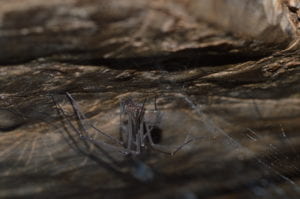This post comes to us from NYU Sydney biology instructor Sean Blamires. He also took the photographs. His research was the focus of the film Sixteen Legs.
On Sunday, March 18, the documentary movie Sixteen Legs premiered in Sydney. Earlier in March, New York University students got rare behind the scenes glances at the making of the documentary and a chance to meet the director, Niall Doran.
The movie is an interlinking journey across the Tasmania culminating in rare footage of giant cave spider mating behaviours and is well worth a look. The novelty of the film is its intertwining themes that combine tourism, education, art, natural history, science fiction and fantasy. While an impressive compendium of celebrities, comedians, and scientists appear in the film, the star is unquestionably the cave spider itself, Hickmania troglodytes.
With a leg-span of up to 18 centimetres, Hickmania troglodytes is an intriguing animal on many levels. It has an evolutionary history dating over 100 million years, as such it has outlived the dinosaurs. It has a lifespan of over ten years, which is rare among spiders. Being a troglophile it spends its life in caves but can survive outside if it needs to. H. troglodytes belongs to the Family Austrochilidae. H. troglodytes is found only in Tasmania, while all other extant members reside in Chile. The Austrochilidae is of particular interest to Arachnologists because they are thought to represent the nexus between modern ‘true’, web building, spiders (the ‘Araneomorphs’) and more ancient non-web builders (the ‘Mygalomorphs’). Add to all of this H. troglodytes has a slow but deliberated, complex, and measured copulation behaviour, involving males tapping female’s heads, kinked forelegs, spider bondage, contortionism, and even cannibalism, all over the course of several hours.

A web in a cave under torch light. This distinctly shows the cribellate silks as they appear blue in this light
While this animal’s sexual exploits are undoubtedly impressive, my interest is in its massive horizontal sheet web and the types of silk it uses to construct it. My collaborators (including Niall Doran) and I have examined the main structural silks in H. troglodytes web and found that larger, older, spiders use tougher silks. We presume this is because the web needs to support the larger spider’s mass or that the webs of larger spiders catch bigger prey.
To capture insects in their webs modern spiders can make their capture threads sticky by using a type of silken (aggregate) glue, while more ancient spiders, such as H. troglodytes, secrete bundles of fine silk threads called cribellate silk to entangle prey. Interestingly, cribellar silk is thought lose its adhesion in humid environments. However, the cave environments where H. troglodytes builds their webs often have humidities exceeding 95%. We are therefore investigating how their cribellate silks can withstand moisture and whether water might even enhance their silk’s stickiness.
There are other projects on this spider and in Tasmanian caves in the pipeline, which we are keen pursue. We plan to one day take New York University students on our expeditions.
Reference:
Piorkowski, D., Blamires, S.J., Doran, N., Liao, C.P., Wu, C.L. & Tso, I.M. 2018. Ontogenetic shift towards stronger, tougher silk in a web building cave spider. Journal of Zoology. 304: 81-89.
